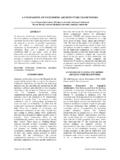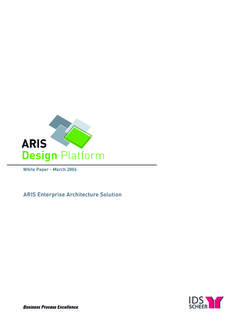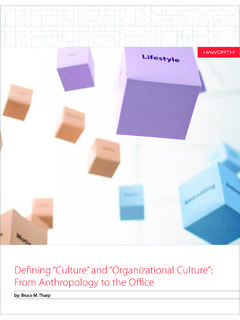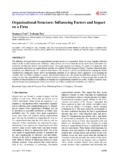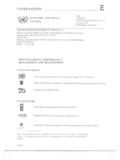Transcription of Organizational Structure What Works - Ossie …
1 Session ID: PROF-001 Session Classification: Professional DevelopmentEvan WheelerDirector, OmgeoOrganizational Structure what WorksOnce you have gotten past the first few months, you will be presented with several important decisions, like how to organize your team. Attendees will hear several approaches to handling critical security functions such as governance, operations, privacy, and incident investigations. There are so many ways to integrate information security responsibilities into the organization, and security officers are meeting the modern day challenges by evolving their program into a more decentralized group spread across various business Security Functions & RolesOrganizational ApproachesReporting StructureDoing More with Less2 Security Team s Responsibilities Interpreting, applying, and enforcing security directives Provide an oversight role More like an internal consultant to the organization3 InterpretApplyEnforceYou should really approach an information security program as if they are consultants hired to help guide the business.
2 The majority of your time should be spent interpreting security policies & standards, and helping the organization understand how and when to apply them. If you are spending all your time with enforcement, then either the educational aspects of your program are failing or you don t have the necessary support from the leaders in the major component of your security program will be identifying areas of the organization that don t meet internal policies and standards, assessing the risk of non-compliance, and working with the business owners to address the risks. This constant review should be a major part of your Information Security Risk Management program. As it sounds, this is the process of ensuring that established security standards are being followed and identifying any gaps, not ensuring 100% compliance. The goal is to identify high risk areas for your organization, and help them prioritize remediation efforts.
3 The more you can distance yourself from each risk personally, and try to focus on the mission of the organization, the better chance you will have balancing out the various pulls on days it is becoming less common for the security team to have a staff of operational/technical engineers managing and monitoring security devices, especially in medium to small size organizations. The role of a security manager is evolving more into a governance and oversight focus. Provide guidance and tools for the existing operational teams to perform their daily function, and regularly assess their effectiveness, but don t feel like you need to have your team s hands on every security related Functions Non-Technology Functions Training & Awareness Policy Development Technical Operations Identity & Access Management Network Security Administration Security Services Security Risk Management Incident Management Enforcement Regulatory & Standards Compliance4 Information Security has a broad set of responsibilities, ranging from training & awareness to digital forensics.
4 Given this wide range of job roles, there are many ways to organize your team. You can look at breaking out the team in several different ways, for example by organizing the team into the four categories shown above, it aligns both the skills and the primary functions of the team at it this way, it is also easy to find functions that can be distributed to other functional groups outside of the direct security team. For example, the IAM function can easily be performed by an IT operations team, or training content may be developed by the security but presented by fulltime Security Roles5 Source: IT Security EBK - A Competency and Functional Framework for IT Security Workforce way to look at organizing your security team is to look at different security competencies and map those to job roles. For example, the Department of Homeland Security has developed this matrix which is organized by 4 different : Functions that encompass overseeing a program or technical aspect of a security program at a high level, and ensuring currency with changing risk and threat : Functions that encompass scoping a program or developing procedures, processes, and architectures that guide work execution at the program and/or system : Functions that encompass putting programs, processes, or policies into action within an.
5 Functions that encompass assessing the effectiveness of a program, policy, process, or security service in achieving its provides a great guide for HR and hiring managers when writing new job descriptions, and can be a good reference of possible responsibilities when making Organizational example, the CISO is responsible for overseeing and designing the forensics function, but would also responsible for evaluating the effectiveness of the incident management function. This highlights a key flaw with the matrix, in that it doesn t represent the essential role of the CISO as being the coordinator during major security Approaches Centralized Allows for specialization Operational / technical focus Time spent on people management Decentralized Conflict of interests More focus on governance Leader vs. just a manager Hybrid Mostly security part-timers Cost savings Training can be a challenge7A centralized security function allows for specialization because there are usually more staff members, so people can focus on incident response, IDS traffic analysis, or maybe training & awareness, however, with a larger team you will spend more time managing people and less time doing hands-on security work .
6 Let s face it, in some organizations even incident handling can be afulltime a decentralized approach, you are more likely to focus on governance, but you still spend a lot of time managing the politics of getting resources from other functions to carry out the work . The resources you rely on don t directly report to you, so you have to be more of a leader than a manager in order to motivate and hybrid approach is a cross between the two, and can often be the most effective in medium and small sized organizations. In this model, you have resources that are only partially allocated to security work , so you end up having to compete with other objectives. But this is easier to sell to senior management, because it is a less expensive option. Getting the proper training and keeping these resources current can be a struggle is the enemy of investment in training for security staff. You sink a lot of time and money into training someone to perform specialized security roles, only to have them leave for a better position at another company.
7 With each of these three approaches, it can be challenging to keep skills current, and avoid turnover as their skills become more Size Matter?8 Security leaders should be careful not to be seen as trying to build their own empire of security staff. When the size of the security team starts to dwarf some equally critical functions, you are just putting your team at risk for an undesirable level of scrutiny. With that said, the demands on the security function certainly aren't decreasing, so it can be challenging to reconcile these facts. This shows one example of a possible reporting Structure for the security team and some other related functions within the organization. Depending on the size of your organization you may be dealing with a jack of all trades IT person who is stuck with security as one part of their responsibilities, all the way up to large organizations with several departments under the CISO specializing in everything from security architecture to access administration.
8 Many organizations have dedicated Security Operations Centers staffed with security analysts 24/7, or mobile forensic teams. Even teams of security application testers or red teams on staff. This will somewhat depend the on mission of your organization, which functions you choose to build out and staff fulltime, versus rely on other functions within the organization. 8 Who s the Boss? Information Technology (CIO) Possible conflict of interest Focus on operations / uptime / responsiveness Functions closely aligned Facilities & Safety Mission closely aligned Culture gap Budget Constraints Risk Management (Chief Risk Officer) Strategic focus Broad view across functions No operational responsibility9 Does it really matter who you report to? CIO, CTO, COO, CEO, is it all the same?Sometimes in the organizations where the IT function reports into the CFO, this can be to your advantage from a budget perspective.
9 More commonly you will find that the information security function will report into the CIO as it grew out of the IT function. This can present a conflict of interest for the CIO when security controls are required that increase the complexity of operations, requires additional downtime for remediation, or slows responsiveness of systems. The upside is that the security team Works more closely with the IT team than almost any other function including compliance and legal, so having a common boss and peer relationship can help to improve relationships if everyone feels like they are part of the same functions including physical security, personnel security, and safety are closely aligned with the missions of information security. Mostly this comes into play during investigations that have a physical component, but can include security offices and data centers, or protecting senior executives travelling abroad.
10 One of the challenges is that the backgrounds for physical personnel are very different than most information security professionals. You are more likely to find former military or law enforcement in the physical security teams. The same is often true for digital forensic staff, so this is a possible alignment point. In terms of reporting into this group, it is not desirable for budget reasons. The facilities function s budget rarely increases over time, and the cost of maintaining growing information security demands can be at far not often implemented, is the CRO role. Having security not just under this heading, but tightly integrated into this group is strategically very forward thinking. Risk management at an enterprise level has a very broad view of issues and concerns across the organization, which means that any security risks will always be rightly compared to exposures in other domains, and hopefully appropriately balanced.


